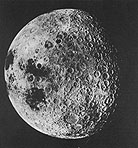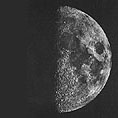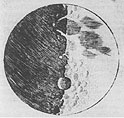 |
 |
 |
 |



How was the first telescope invented? It seems likely
that the telescope was invented after a lens polisher recognized
the qualities of lenses and thought of a way to use them to see
from a distance, by magnifying objects. This led him to the idea
of using two lenses.This happened in the Netherlands in 1608, and three
different people, Hans Lippershey, Zacharias Jansen and Yamas
Matius all have claims to the title of the "first inventor." Each of
them was a lens polishing expert. Indeed, a great deal of expertise
was required to create particularly durable lenses. Lippershey's
telescope was probably the most sophisticated.The first telescopes developed in the Netherlands had a
magnification capacity of four to ten times - which is rather limited
if compared to present-day optical instruments - but it was an
amazing innovation at the time which so thrilled people that the
telescope became the most popular "toy" in Europe.It was in June 1609 that Galileo first heard of the new instrument and its structure. He quickly set about constructing a telescope of his own.
He began to assemble lenses of different shapes separated by varying distances. He hoped to build a telescope capable of providing greater magnification and more visual precision than the existing telescopes imported from the Netherlands. Within a month, Galileo succeeded in creating the first astronomical telescope.
How does the telescope produce magnification? How was Galileo's telescope built? Effect of the telescope on science. Why was Galileo interested in the telescope
and how did he use it?Can one rely on observations made through the telescope? Later uses of the telescope.
The telescope is made of a hollow cylinder in which lenses have been fixed at both ends: the eye lens (the eyepiece), which is placed close to the observing eye, and the objective lens which is more distant from the eye. In Galileo's telescope the objective lens is a convex lens (also termed focusing lens) and the eye lens is a concave lens (also termed a diffusing lens). Modern telescopes make use of two convex lenses.
How does the telescope produce magnification?
The basis of the telescope is the fact that lenses focus and diffuse the light which reaches them. Light emitted from an object (AB) placed at a distance from the convex lens, creates an identical image (in a different size and upside down) on the other side of the lens (A'B'). This image is termed the actual image because the light rays are actually falling on the place where we see the image, and it is possible to view the image on a screen, or in some other way, even if we are not looking through the lens.
If we look through a concave lens or through a convex lens at an object near the lens, the image of the object will be seen on the same side of the lens where the object is situated. This image is called a virtual image, for it can only be observed by the person looking through the lens. If we place a screen in the same place we see nothing, for there are no light rays at the spot where the image is viewed. If we place the object at certain distances near the lens, the image will seem larger than the object.
In fact, the telescope uses both these characteristics in order to enlarge objects (AB) that are at a distance. The objective lens creates an actual image (A'B') of the object which we wish to observe close to the eye-lens. This actual image creates another image (A"B") which is a virtual image completely identical to the object. The objective lens serves to bring nearer distant images, such as the stars, and the eye lens is used to magnify the small image obtained by means of the objective lens. By changing the distance between the two lenses, it is possible to reach an adjustment so that the actual image is at an appropriate distance from the eye lens, through which the image will appear magnified.
How was Galileo's telescope built?
In the summer of 1609, Galileo first received word of the telescope and he immediately set about building such an instrument. In this work, he was aided by the lens polishers of Venice, which was one of the two great lens polishing centers at the time. These lens polishers managed to polish for Galileo stronger lenses than were used in other telescopes. Within two months, Galileo completed the task of building the first astronomical telescope. Like the Dutch artisans, Galileo also used his knowledge of lenses and a process of trial and error in order to improve his telescope. He had no sound scientific theory to go on. His scientific activity with the telescope began with the uses to which he put the telescope rather than with building one. Galileo succeeded in assembling a telescope with more magnifying power than any telescope before it. With the sophisticated telescope he built it was possible to view objects at a magnification of twenty times.For many years, other tried to build a telescope with greater power of magnification than Galileo's, but to no avail. It was only from the middle of the 17th century onward that telescopes based on two convex lenses were first built. These types of telescopes have a greater magnification capacity and a wider angle of vision (i.e., one can see a larger area at one time). From the end of the 17th century onward, telescopes containing a convex lens and a concave mirror were also built. Strong modern telescopes make use of a mirror and are a few meters long. The various types of binoculars built over the years are also based on the principles of the telescope and are in fact two telescopes joined together.

When building his telescope, Galileo did not think of the scientific uses of this instrument, its technological capabilities seeming to him sufficiently important. It was after few months he had built the telescope that Galileo began using it to observe the heavens. Following these observations, Galileo realized he was holding a new and powerful tool which would enable him to see things which had never been seen before. These observations were also apparently intended to pave his way to his new position in the Court of Tuscany.
Effect of the telescope on science
Galileo was not the first to use the telescope for observing the heavens, but he was the first to do so methodically. His first methodical observation was of the earth's nearest celestial body - the moon. He tried to map the moon and study its shape in order to learn what it was made of.
 |
|---|
(From - The Cambridge Atlas of Astronomy. ,p.98-99)In that period, science was dominated by the geocentric theory. The geocentric theory posits a static earth in the middle of the cosmos. This theory was based on Aristotelian physics, according to which the supra-lunar universe, i.e., from the moon outward, is made up of a uniform and pure material called ether. All of the celestial bodies are made of this ether and they are all smooth spheres whose movements are perfectly circular.
Observing the moon in order to validate this theory, Galileo discovered that the moon was not a smooth sphere but rather mottled with light and shadow which, Galileo explained, indicated the mountains and valleys on the surface of the moon. In other words, he discovered that the moon was similar to the earth. Galileo described the appearance of the moon as seen through his telescope in his book Messenger of the Stars.
 |
 |
|---|
(From - Planetary Astronomy from the Renaissance to the rise of Astrophysics, part A. By R. Taton & C. Wilson. ,p.83)Galileo's conclusions regarding the existence of mountains and valleys on the surface of the moon were not acceptable to all. Other astronomers who observed the moon through telescopes saw the same spots on its surface but claimed that these were neither mountains nor valleys, but simply spots of color on the surface of the moon. Through observation of the moon alone it was difficult to determine if the moon was smooth, or dotted with mountains and valleys. Galileo pointed out the changes of light and shadow on the moon, which he explained as arising from the shadows which the mountains cast over the valleys. It was a convincing claim for the existence of mountains on the moon, but other explanations could be given for the changes in light and shadow. It is important to remember that in the period under discussion any explanation arrived at on the basis of results obtained by using Galileo's telescope was by no means a simple and foregone conclusion. The very fact that Galileo expected to find mountains and valleys on the moon helped him to see them with his telescope. Today, using advanced instrumentation we know for certain that Galileo was right in his assumption that there are mountains and valleys on the moon.
This discovery helped Galileo to refute Aristotelian physics and its theory of the heavens. The description of the moon was important for proving Galileo's claim that the planets are in fact similar to the earth in nature and that the earth itself was a planet.
Galileo made two additional important discoveries with the aid of his telescope. On January 7, 1610, during one of his first observation sessions with the new telescope, he discovered the moons of Jupiter. Galileo published his findings concerning the surface of the moon and on the moons of Jupiter in his book Messenger of the Stars, published in 1610. His second important telescopic discovery was made two years later, when he observed sun spots.
One of the claims raised by the adherents of the geocentric theory, as opposed to the heliocentric theory, was that all planets orbit the sun alone and only the earth is accompanied by a moon. According to this logic, since no planet had a moon, the earth which has a moon cannot be a planet. This claim was refuted by Galileo's discovery of Jupiter's moons. Jupiter's moons were an example of planets revolving around a planet, Jupiter, which meant that they were in fact moons, and this therefore disproved the claim that planets cannot have moons. The earth is thus not unique as a planet which revolves around the sun and has a moon revolving around it, for Jupiter is in a similar situation.
Why was Galileo interested in the telescope and how did he use it?
Social influence
The ability to see distant objects as if they were close at hand appealed to many people. Various governments were quick to see the possibilities of such an instrument for military use. The ability to view enemy forces before they arrived could give any army an advantage, and the ability to see things from a distance would also serve seafarers and the port personnel who had to locate approaching ships. The telescope or binoculars became standard equipment on ships and in military gear.The initially enthusiastic reception of the telescope had nothing to do with observation of the skies, but rather revolved around the ability to see terrestrial objects. Galileo heard of the Dutch telescope while a professor at the University of Padua, which was part of the Republic of Venice. The Venetians realized the great value of the telescope for their merchant fleet as well as for use on dry land, and the State Council therefore encouraged and supported Galileo to continue his investigations and to develop his own telescope. A letter which Galileo wrote to his brother-in-law illustrates the enthusiasm felt by Galileo and the Venetians over the new Dutch invention. Galileo hoped to receive a considerable raise in his university salary (paid him by the Republic of Venice) following the invention of the telescope, but these hopes were dashed. Following fiscal disagreements, he left Venice a year later for a position as philosopher and mathematician in the Court of Tuscany. In this position he was relieved of his teaching duties.
In 1616, the Inquisition included the theories of Copernicus on the forbidden list and defined it as nonsense, foolishness and heresy. Galileo was allowed to investigate and developed the theory on the basis of various hypotheses, but no more than that. The general public, the nobility and the people of the church tended -- each for their own reasons -- to disagree with Galileo's new findings in astronomy, which were based on Copernican theory.
Bertolt Brecht's drama, "The Life of Galileo" is an excellent portrayal of the fears of the people:"The Little Monk:
I grew up among the farmers of Champagne, the simple folk who know everything about olive trees and precious little besides ... their situation was not good, but underlying their very miserable existence there was a certain order. They are subject to the cycles of the year. What gave them power was their inborn sense of continuity and necessity which came from their contact with the earth and the trees which grow green again every year. They had been assured that God could see them. What would all these people among whom I have grown up say if they heard from me that they are in fact living on a small sliver of stone which constantly revolves in empty space around another star, which is only one - and not necessarily the most important one - of many others? Would their patience, their willingness to suffer be a required or good thing in this case? If the scriptures - which explain everything and establish the reasons for the necessity of sweat and patience, hunger and submission - were now found to be mistaken, of what value would they be? I can see how these folk would feel cheated, betrayed... we must keep our silence now for the loftiest of ideals - the peace of mind of those who live in misery."
The above passage also helps us understand why both the clergy and the nobility feared new discoveries which were capable of shaking the foundations of the establishment.In 1623, following the rise of Berberini to the papal throne, Galileo decided to resume his astronomical investigations after an interval of many years.

Can one rely on observations made through the telescope?
The success of the telescope was indeed great, but some physicists of that era claimed that one cannot rely on it in order to learn about the world. They asserted that artificial means are not sufficient in studying nature. At the beginning of the seventeenth century no instrument had yet been used for learning indirectly about the world. The claims against the telescope revolved around the question of whether what we see through it indeed exists in nature, or is produced by the instrument itself. If we were to look through a red piece of glass, for example, the world would seem to us to be red. Likewise, perhaps the spots we see when we look through a telescope do not really exist on the surface of the sun, and the mountains on the moon are not real.
Those using the telescope pointed out that when the instrument was used to view sites on the face of the earth, the images viewed were not distorted. Ships seen through the telescope were identical in shape to those seen close up. Moreover, the changes and cycles noted in celestial observations also indicate that they are not a product of the instrument itself, for if they were, they should have seemed the same everywhere. The use made of the telescope and other optical devices was constantly expanding and researchers began using more and more optical instruments in order to view the world. In order to test the reliability of the instruments, a large and complex series of tests were conducted before they were recognized and adopted as scientific tools. It is always good to ask ourselves whether the phenomena we observe exist in the world or only in our measuring instrument.
The telescope cannot prove that the geocentric theory is right. As we have seen, it makes possible additional defenses of the theory. The great importance of the telescope is in the development of astronomy, and the discovery of additional stars and planets. Telescopes made it possible to measure the course of planets with increasing precision, and to evaluate the characteristics of stars, discover the existence of double stars, novas and distant galaxies. The telescope is in fact the main space-investigation device.
Later uses of the telescope.
What would have happened if there were no telescopes? Would we have known that the earth revolves? What is the special use of the telescope
in military service/navigation?
"And word having reached Venice that I had made one telescope, it is six days since I was called by the Signoria, to which I had to show it together with the entire Senate, to the infinite amazement of all; and there have been numerous gentlemen and senators who, though old, have more than once climbed the stairs of the highest campaniles in Venice to observe at sea sails and vessels so far away that, coming under full sail to port, two hours and more were required before they could be seen without my spyglass. For in fact the effect of this instrument is to represent an object that is for example fifty miles away as large and near as if it were but five."
Letter to Galileo's brother-in-law (From : Galileo At Work - His Scientific Biography, By - Stillman Drake, The University Of Chicago Press, p.141)

| Andrea / | Mail / | Home Page |
|---|
 |
 |
 |
|---|
![]() KNOWMAGINE - http://muse.tau.ac.il/~vrmus
KNOWMAGINE - http://muse.tau.ac.il/~vrmus